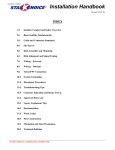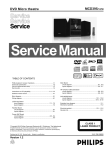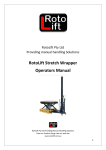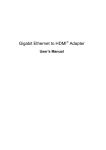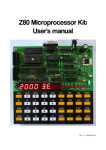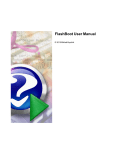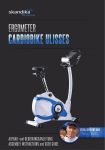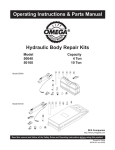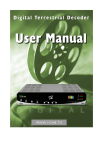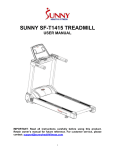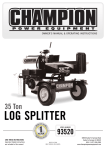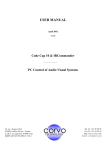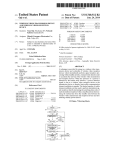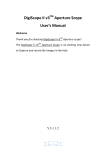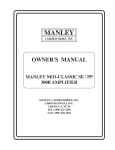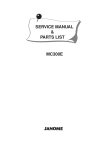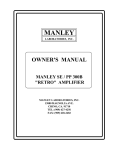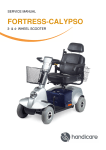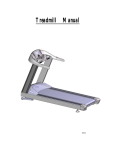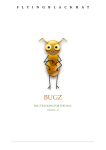Download woodmaxx WC8M Manual Winter 2014
Transcript
TABLE TABLEOF OF CONTENTS CONTENTS All content in this manual; pictures, and text are the sole property of WoodMaxx™ Power Equipment Ltd. © 2014 No unauthorized reproduction. INTRODUCTION CONGRATULATIONS! You have just purchased the WoodMaxx™ WM-Series Wood Chipper, the strongest, safest and the most compact PTO wood chipper available. We have compiled this owner’s manual to help you understand and appreciate your chipper. By taking a few minutes to read this manual and understand the maintenance instructions, it will give you better performance and extend the life of your chipper. Read the manual before operating the chipper. SET-UP INSTRUCTIONS Your chipper does need to be set up prior to installation. It arrives in a steel crate that can be dismantled in minutes. See Assembly Instructions The in-feed bin and discharge chute are shipped with the unit and are located in the bottom of the steel crate. Visually inspect the in-feed bin, and the fly wheel before attaching to tractor, and applying power to ensure that nothing is in the chipper head. If the chipper deflector or any of the guards have been removed for shipping, be sure to replace them properly before use. The PTO (Drive-Line) is also shipped with the unit and is located in the bottom of the steel crate. When mounting, keep the chipper as close to the tractor as possible. Make sure that the PTO shaft will not bottom out in the shortest position. While in use, keep the PTO shaft straight. No more than 15 degrees from level is acceptable. Do not operate the chipper without the chip deflector properly in place. Read and understand all assembly instructions prior to assembly. 1 ASSEMBLY INSTRUCTIONS Assembly Time 2.5 Hours Before you get started, there are a few tools you will need: • 13mm Wrench (same as 1/2”) • 16mm Wrench (same as 5/8) • Adjustable Wrench • 3/16 Allen Wrench • 6mm Allen Wrench Remove the plastic wrapping from the crate and inspect the chipper for any obvious shipping damage. Remove and unwrap all the chipper components that are packaged in the crate. Remove the cardboard box from the in-feed bin. This box contains the user’s manual, hardware packet, extra shear bolts, and any additional item that you may have purchased such as extra chipper knives. [Fig. 1a] Fig. 1a Open the hardware packet and organize the enclosed fasteners into separate piles. There is a picture of the hardware on pg. 4 of this manual that you can use as a guide to ensure that you use the correct hardware in the upcoming steps. Remove the four bolts that secure the top of the crate frame. Remove the top of the crate, and set it aside. Located on the bottom of the crate is a cross bar that secures the chipper to the frame. Loosen the two bolts that hold this bar in place, and drive the bar forward with a dead blow hammer. [Fig. 1b]. Fig. 1b 2 ASSEMBLY INSTRUCTIONS Locate the lift point on the top of the chipper. This is the balance point, and the only point the chipper should be lifted from. Using a chain or strap that is rated strong enough to lift the weight of the chipper, lift the chipper out of the crate. [Fig. 2] If you do not have a front end loader, attach the three point hitch of your tractor to the chipper to lift the chipper out of the crate. Measure the distance from the PTO spline of your tractor to the ground [Fig. 3]. Write down this measurement here ________. You will need it for the next step. While the chipper is raised in the air, attach the four adjustable base legs so that when the chipper is on the ground, the spline of the chipper is slightly lower than the spline of your tractor. [Fig. 4]. The shaft does not need to be perfectly horizontal, but it is recommended that the slope of the PTO shaft is no more than 15 degrees. [Fig. 5] Fig. 2 Fig. 3 15° Fig. 4 Fig. 5 At this time, carefully lower the chipper to the ground, and remove the chain or strap 3 ASSEMBLY INSTRUCTIONS In-feed bin left side panel In-feed bin right side panel In-feed roller assist lever In-feed bin bottom panel In-feed bin top panel Hardware box & accessories Adjustable base legs Support leg Discharge chute (20)M10x25mm (2) CAT 1 Draw Pins (5) Clevis Pins (4)M10x15 (1) Spring Removal Tool (20)M10 Lock Nuts (4) Lock Washers (1) 5/8”x4” Pin (2) 1/2”x4” Pins (8) Fender Washers (4) 2-Hole Straps (38) 10mm Washers 4 ASSEMBLY INSTRUCTIONS Use Fender Washers Here Outside mount (bolt, fender washer) Fig. 6 Inside mount (washer, lock nut) [Above] View of proper assembly of in-feed bin using 2 hole straps. All other bolts are typically assembled as follows; bolt- washerpanel-washer-lock-nut Attach the left panel of the in-feed bin using two of the 2-hole straps and two M10x25mm bolts. Straps will bend when tightened down. This panel can be identified by the two small holes on the bottom of the panel where the fasteners for the support leg attach. [Fig. 6] Attach the right side panel in the same manor. [Fig. 7] Attach the bottom panel of the in-feed bin, by first inserting the two M10x25 bolts through the side panels in the two holes closest to the feed roller. Do not tighten these bolts yet, and allow the panel to hang vertically. [Fig. 8] Raise the bottom panel in place and insert the two M10x25 bolts the side panel in the two holes closest to the end of the panel. [Fig. 9] Fig. 7 Fig. 8 Install the remaining four M10x25 bolts in the remaining four holes in the lower panel. Fig. 9 5 ASSEMBLY INSTRUCTIONS Before tightening the bolts, ensure that the lower panel is slightly higher than the in-feed bin. This will prevent material from hanging up where the two pieces join together. [Fig. 10] Fig. 10 Attach the top panel of the in-feed bin by installing the four M10x25mm bolts in the two forward holes of the panel. Affix the safety bar stop to the top left of the in-feed bin. [Fig. 11]. Fig. 11 Attach the support leg with two M10x25 bolts. [Fig. 12]. Remember, the support leg should be in the down position during storage only. When the chipper is attached to the tractor, the support leg should be in the up position at all times. Fig. 12 Attach the upper feed roller assist lever using four M10x25mm bolts. [Fig. 13]. Note: Although we choose to install the hardware with the bolts pointing into the in-feed bin, it is acceptable to point them outward to avoid the possibility of branches catching on the bolts. 6 Fig. 13 ASSEMBLY INSTRUCTIONS Fasten the chain from the upper feed roller assembly to the feed roller assist lever. The hardware for this is found located on the end of the chain. [Fig. 14]. Connect the safety bar to the top side of the in-feed bin. First remove the bolt and nut on right arm of the safety bar. Hold the safety bar in place, so that you can read the word STOP, and the arrows point downward. Hook the bolt on the left arm of the safety bar through the hole on the top of the edge of the left in-feed panel. [Fig. 15]. Align the hole on the right arm of the safety bar with the hole in the top edge of the right side panel, and reinstall the bolt and nut that you removed in the previous step. [Fig. 16]. Fig. 14 Fig. 15 Thread a M10 locknut onto the bolt on either side, but do not tighten these nuts. This is a hinge point and the bar must move freely. [Fig. 17]. Adjust the clutch cable length so that it is tight but not so tight that it starts to disengage the clutch. Attach the end of the clutch cable to the safety bar. [Fig. 18]. Fig. 17 Fig. 16 Fig. 18 7 ASSEMBLY INSTRUCTIONS Note: Please check to make sure all nuts and bolts on machine are tightened after you complete assembly, and before machine is first used. This step has not been done for you prior to shipment, except for the flywheel bolts and knife bolts. Fig. 20 Affix the discharge chute to the chipper using four M10x15mm bolts along with the four 10mm lock washers that were included in the hardware packet. [Fig. 20]. Fig. 21 Connect the chipper to the 3 point hitch of your tractor. [Fig. 21]. Or, if you have one, connect using your category 1 quick hitch. [Fig. 22]. Fig. 22 Next you must measure to determine the proper length of the PTO shaft Measure the distance from the end of the spline of your tractor to the end of the spline of the chipper. This is the Measured Shaft End Distance, or MSED. [Fig. 23]. Fig. 23 8 ASSEMBLY INSTRUCTIONS Now, the shaft must be sized according to this measurement. Refer to the chart on the bottom of page 18 to determine if the shaft must be cut to size. If so, see the “PTO shaft cutting instructions” on page 19 . After properly sizing the shaft, locate the three grease fittings on the shafts U-joints, and pump several shots of high quality grease into the fittings. [Fig. 24]. NOTE: Check to ensure that the zerk (grease) fittings are screwed in tight. Occasionally, dried paint may cover the end of the zerk fitting on the PTO shaft. Remove this by scraping the paint off with a knife prior to attempting to pump grease into these fittings. Attach the PTO shaft from the tractor to the chipper. Notice that one end of the shaft has a shear bolt, this end should be attached to the tractor. [Fig. 25] Fig. 24 CHIPPER END Fig. 25 NOTE: Prior to shipping the chipper to you, the following service has been done in our warehouse: • Drive belts have been adjusted and tightened • Bearings on the chipper have been greased • USA made knives have been installed, adjusted • Knife bolts were torqued to 40 ft. lbs. Setup is now complete. Please read and understand all of the operating instructions before using the chipper. 9 Fig. 26 TRACTOR END SHEAR BOLT DRIVE LINE SAFETY TIPS Agriculture and forestry are recognized as one of the most hazardous of occupations. Today’s farmer spends long hours in close proximity to increasingly complex and powerful machinery. To avoid accidents, everyone from the component supplier and the company who manufacturers and assembles the machinery, to the dealers and ultimately the actual user, must keep safety in mind. The checklist below relates to the drive line of agricultural implements, general safety literature, and the standards published by the American Society of Agricultural Engineers. DRIVE LINE SAFETY CHECKLIST Drive-Line Specifications – The first step towards safe applications is to specify and test the drive-line so that it operates properly under expected field conditions. 1. Specify and test the proper size joints and telescoping members based upon the power required by the implement, speed of rotation, joints angles, shock loads, and expected life. 2. Test the hitch geometry to prevent the drive line from: • Extending beyond the recommended maximum length. • Bottoming out. • Reaching a position that allows universal joints to lock. • Exceeding the maximum allowable angle for constant velocity of the universal joints. Information concerning these parameters may be found in all drive-line manufacturer’s catalogs. 3. Specify and test telescoping members to allow the lowest possible thrust loads, considering the expected working conditions. 4. Specify and test torque limiters to control excessive shock loads. 5. Where necessary, specify and test overrunning clutches to prevent inertial loads from overpowering the tractor. 10 DRIVELINE SAFETY CHECKLIST Hazard Reduction - The second step in specifying a safe drive-line application is to strive to eliminate as many hazards as possible 1. On drive-line with torque limiting or overrunning devices, specify that the device be positioned to the end of the drive-line by the implement. 2. For implement connections which require bolts or set screws, select and/or supply hardware which minimizes protrusions. Information concerning these parameters may be found in all drive-line manufactur- er’s catalogs. 3.For tractors PTO shaft connections, specify a safety type yoke (twist or slide collar) to minimize protrusions. 4. Provide a proper clearance zone for the operation of the drive-line, to avoid damaging the shielding components. Some common areas of interference are: • Three point linkage. • Extended or eye loop hitch pins. • Hydraulic hoses. Guarding – For hazards which cannot be eliminated effectively, guarding must be provided whenever feasible. The PTO master shield, integral drive-line shield, and implement input connection shield should provide an interactive guarding system. 1. Provide instructions by labels or manuals. The implement should be used only with the tractor’s PTO master shield in place. 2. Specify and test an integral drive-line shield with end cones which overlap, but not interfere with the PTO master shield or implement input connection shield. 3. Provide an implement input connection shield to interact with the integral drive-line shield to provide guarding of the shaft coupling and any torque limiting devices installed on the drive-line. 4. Check that all routine maintenance of the drive-line can be done without removal of the shields. 11 DRIVELINE SAFETY CHECKLIST Warnings and Instructions – Provide warnings and instructions for hazards associated with the machine. Provide instructions for proper maintenance and repair. 1. Provide labels on the unit to advise the user of proper hitch dimensions and maximum safe operating speed. 2. Check that proper danger labels are supplied with the drive-line con cerning these parameters may be found in all drive-line manufacturer’s catalogs. 3. Provide easy-to-understand instructions for proper drive-line operation, maintenance, and repair in the operator’s manual. 4. Advise against the use of PTO adapters which may defeat the purpose of the tractor’s master shield and adversely affect the performance of the drive-line. 5. Advise the user of locations of genuine original equipment spare parts. Further information about drive-line specifications and safety may be obtained from your drive-line supplier and the following ASME standards and engineering practices: S203 – Rear power take-off for agricultural tractors S205 – Power take-off definitions and terminology for agricultural tractor S207 – Operating requirements for tractors and power take-off driven equipment implements S318 – Safety for agricultural equipment S331 – Implement power take-off drive-line specifications S333 – Agricultural tractor auxiliary power take-off drives S350 – Safety alert symbol for agricultural equipment S441 – Safety signs S493 – Guarding for agricultural equipment EP363 – Technical publications for agricultural equipment Other standards may apply for particular types of implements. All drive-line manufacturers strive to produce a safe product. Drive-lines, like most other components must be used properly, including the use of proper tractor master shields and implement input connection shields. Please contact us if you have any questions about your drive-line applications. 12 SAFETY INSTRUCTIONS Do not attempt to operate the chipper until you have read and understand the owner’s manual. If you need a new one, you can visit www.wooodmaxx.com Keep the decals in place and in good repair. We will furnish new decals upon request. It is NOT recommended to operate the chipper in temperatures below freezing. Hardened steel (as used on knives) can become brittle in temperatures below freezing and may result in breakage. Always keep the guards and chip deflector installed properly while operating the chipper. Never leave the chipper running unattended. Do not attempt alterations, repairs, or adjustments while the flywheel is turning. Always disconnect the PTO, stop the tractor’s motor, and put the keys in your pocket prior to attempting any alterations, repairs or adjustments. Keep hands, feet, and other extremities out of and away from the hopper (in-feed bin). Point the discharge chute away from doorways, sidewalks, or any other area where your view is obstructed. The chute should be pointed downwind when possible. This will keep the chips from blowing back in the operator’s direction. Keep everyone, especially children, away from the area of operation. No loose clothing should be worn around the chipper. Personal injury can occur if someone or something turns the flywheel over when the knives are WEAR PROTECTIVE GEAR! EYES – wrap around safety glasses EARS – ear plugs HANDS – leather gloves FEET – steel toed boots LEGS – heavy pants ARMS – long sleeved shirt 13 MACHINE CHECKLIST CAUTION: Visually inspect the in-feed bin and the flywheel before applying power to ensure that the chipper head is clear, all the bolts are clear, and the knives clear the case and the cutter bar. Make sure that: 1- Bystanders are at a safe distance from chipper during operation 2- Children should NEVER operate, or be near the chipper during operation. 3-The PTO shaft does not come apart or bottom out during the normal lifting range. Check the chip pile to see if the knives need to be serviced. Long slivers in the chip pile are one of the best indicators of dull knives. MACHINE OPERATION The chipper is a flywheel-and-knife type of chipper, not a shredder. The knives actually chip the limbs they are fed into the head. The knives must be sharp to operate properly. Dirt, rocks, nails, or other foreign material will shorten knife life. Before operating the chipper, review the machine checklist. After visually inspecting the fly wheel and in-feed bin to ensure there are no obstructions in the chipper head, start the tractor. Make sure the chipper is firmly on the ground and that the PTO shaft is no more than 15 degrees from level. The chipper must be resting on solid ground prior to operation. DO NOT operate while raised by 3 pt. hitch. Start the chipper slowly (idle) with the PTO engaged. Gradually increase engine RPM until the tractor PTO speed is 540 RPM (not 540 engine RPM) The chipper is designed to run at 540 RPM. Lower RPM can damage the chipper if material jams and stops the flywheel. The material will feed into the head more easily if you start the pieces with the large end first. The feed rollers will fold branches as they are pulled into the hopper. Occasionally, a limb fork may have to be cut to feed properly. If the material stops feeding, sometimes a little push on the long end of the limb will help. 14 MACHINE OPERATION Remember to chip only clean material, or knife life will be shortened. Do not move the chipper while the flywheel is turning. Block the tractor wheels and set the parking brake while running the chipper. Watch the discharge chute while operating the unit, and if the chips stop flowing, stop feeding material into the unit by pushing forward on the hydraulic control valve handle located on the side of the in-feed bin. Most of the time this will be enough to clear the chips out of the unit. If the unit slows down noticeably, first shut off the PTO power, then the tractor. Unplug the head by turning it backwards by hand with the discharge chute and the top section of the flywheel housing wrap off. Remove the chips from the top of the head. If this fails, remove the clean-out door, located in the lower part of the front side-plate of the chipper below the main shaft, and then work the chips out of the case. Replace the clean-out door after all the chips are removed, be sure to use both the lock washers and flat washers. Do not operate the chipper without the chip deflector in place. Before stopping the chipper, be sure that all of the material is out of the chipper head and out of the in feed roller. All of the material in the chute must be gone or the unit could jam on a small piece of material. This can usually be cleared by turning the unit backwards by hand. Dull knives cause many problems such as: seeming lack of power, plugging of the discharge chute, rough cutting with more vibration than usual, feed roll shaft broken, main bearing house broken, main bearing working loose and the flywheel or knives hitting the case or bed knife, feed roller kicking out of gear, and not feeding. When sharpening the knives, be careful to keep angle A at a 37°-39° angle. Knives cannot be rounded, or the knives will not pull the material into the head. (See Flywheel Knife Sharpening Instructions on pg. 22) The best way to tell if the knives need sharpening is to watch the chips coming out of the chip discharge. If they are long and straight, the knives are in need of service. Sometimes the knives feel sharp to the fingers, but may be worn or rounded. They will need to be sharpened. 15 LUBRICATION Bearings - grease all bearings every 10 hours of operation. PTO Shaft – grease the two grease zerks on the universal joints 10 hours of operation with high quality grease. In-feed Roller Drive Axle – lubricate with way oil (chain saw bar oil) every 10 hours of operation. Occasionally remove and thoroughly clean this assembly pg. 26 Feed Roll Clutch – while feed roll shaft is off, lubricate the feed roll clutch inside and out with a high quality grease pg. 26 Gear Box – add oil (90w) as necessary and change after 40 hours of use. Shear bolt replacement-- Grade 2, size 5/16”x 2” PREVENTATIVE MAINTENANCE Visually check all bolts, set-screws and fasteners after running 10 hours, and once per day thereafter. Check for loose belts and broken pulleys, loose springs, dry slides, and proper lubrication of both feed roller drive-axle and feed roller clutch. The main drive belts on the chipper need to be tight. The belt of the main drive on the PTO chipper should be checked every 10 hours of operation. All decals and safety instructions should be kept clean and legible. It is the operator’s responsibility to replace the decals as needed. They will be mailed to you at no charge. 16 TROUBLESHOOTING PROBLEM: Head slows but tractor does not Possible Causes Solution Main drive belts are slipping Tighten or replace if necessary Fly wheel knives dull Sharpen or replace PROBLEM: Feed roll clutch kicking in and out of gear excessively Possible Causes Solution Flywheel knives dull Sharpen or replace Material jammed in chute Release feed roll clutch and remove material by pulling it out of chute. Trim forks and feed in to chute. PROBLEM: Not chipping clean or chip deflector plugging Possible Causes Solution Flywheel knives dull Sharpen or replace Chipper head turning too slowly Check PTO speed at 540 RPM Bed knife(anvil) rounded off Reverse or sharpen PROBLEM: Unit won’t feed limbs properly Possible Causes Solution Not enough down pressure on limbs Adjust eyebolts to increase spring tension Fork in material too wide Remove and trim Feed roll tension springs stretched Replace Feed roll gear box belt loose Tighten or replace if necessary 17 DRIVE LINE FITTING ADJUSTMENTS This data is for drive-line fitting adjustment. Prior to startup, the PTO that is supplied with your chipper must be properly sized to insure proper operation. If this is not done, damage to the chipper, PTO, and tractor PTO drive-line will occur. These calculations are based on the following assumptions: The drive-line has an active length range of 20-3/4” to 25-1/4” The two shaft ends are horizontal with one another The following steps should be taken to insure the proper fitting of the PTO drive-line (provided with your chipper) with your tractor PTO drive. Attach the chipper to your tractor’s three point connections. Raise the chipper to a position where its drive-shaft is level with the tractor PTO drive-shaft. The horizontal position is recommended for operation of the chipper. A maximum of 15 degrees of offset from the horizontal position between the two shaft ends is allowable for proper operation of the unit by the PTO drive-line manufacturer. However, drive-line calculations are based on a level horizontal position. With the two drive shafts level with one another, measure the distance between the ends of the two shafts. (The chipper and the tractor PTO shaft ends). This distance between the two shaft ends is the measured shaft end distance, or “MSED”. [Fig. 23, pg. 8] The PTO drive-line is capable of handling a MSED between 20” to 25-1/2”, allowing for at least 1/3 of shaft overlap as recommended by the drive-line manufacturer. If the MSED is longer than 25-1/2”, a longer drive-line is needed and should be ordered. If the MSED is shorter than 20”, extend the draw arm of the chipper outward until a minimum of 20” is achieved. MSED Between 23-1/4” x 25-1/4” No adjustment needed 22” Cut 1” from each shaft 21” Cut 2” from each shaft 20” Cut 3” from each shaft 18 DRIVE LINE FITTING ADJUSTMENTS Most drive-lines can be adjusted to fit by cutting off equal amounts of the ends of the shaft and the guard tube of the PTO drive-line. In no case can more than 3” of shaft and guard tube be removed, or the contact area is not sufficient for proper and safe operation of the drive-shaft. Cut off the same amount from the shaft tube plastic cover and the guard tube safety cover to insure proper assembly and fit of the drive-line. Consult the driveline manufacturer data enclosed with your drive-line for proper assembly, disassembly, lubrication and operation prior to startup and during operation. REMEMBER: Contact with the drive-line while in use can result in serious injury or death. Any portion of the drive-line while not shielded must be guarded by an interactive guarding system. The manufacturer of the equipment is responsible for providing guards. Any replacement guard must be one which is specified by that manufacturer. In short, do not remove any of the plastic safety covers on the drive-line and insure that caution is used around this drive-line. No one should be in the drive-line area when it is operating. DRIVE LINE FITTING ADJUSTMENTS Note- this is the shear bolt section of the shaft, and this end should be attached to the tractor 5/16”x18x 2” Grade 2 shear bolt To cut the PTO shaft, unhook chain, and separate the two halves. Mark and cut equal amounts off of the plastic shields. Then mark and cut the same mount off of the steel shafts. De-burr , grease, and reassemble the shaft. Shorten the chian so that there is no slack when the shaft is extended to its longest point 19 KNIFE CHANGING/ADJUSTING Tools You Will Need: • Torque Wrench • 17mm Socket • 16mm Wrench/Socket • 6mm Allen Wrench STEPS: Detach PTO shaft from chipper. [fig. 1] Remove shield that covers in-feed drive axle Remove shield that covers drive belts. Remove access panel on front and back of flywheel chamber to expose knife bolts and nuts. [fig. 2] [fig. 3] Fig. 1 Clean and remove any debris that is impacted in knife bolt allen head socket using an awl or other pointed object. Take care to clean these out thoroughly to ensure allen wrench drive bit seats properly. If not, you may strip the heads out. Air blow gun is also helpful. Hold the head of the M10 cap screws with a 6mm allen wrench. From the back side of the flywheel, with a 17mm socket remove the nylon lock nuts. [fig. 3] Fig. 2 Remove the knife. Be careful not to drop the nuts or bolts into the flywheel chamber. If you do - See “Clearing An Object From The Flywheel Housing” Replace knife with new or sharpened knives. Be sure there is no debris between knife and flywheel. Torque knife bolts by holding M10 cap screw heads with 6mm allen wrench, then with a 17mm socket and a torque wrench, tighten nylon lock nuts to 40 ft./lbs. DO NOT over torque bolts or knife breakage may occur. [fig. 3] Replace access covers front and back. Note: Rotate the flywheel by band to check to make sure that both flywheel knives clear the bed knife, without coming into contact with it, before applying PTO power to the chipper. 20 Fig. 3 KNIFE CHANGING/ADJUSTING Tools You Will Need: • Torque Wrench • 17mm Socket • 16mm Wrench/Socket BED KNIFE STEPS: Detach PTO shaft from chipper. [fig. 1] Remove both tension springs from in-feed roller assembly. Raise and support in-feed roller, a short piece of 2x4 works well for this. [fig. 2] Clean and remove any debris that is impacted in knife bolt allen head socket using an awl or other pointed object. Take care to clean these out thoroughly to ensure allen wrench drive bit seats properly. If not, you may strip the heads out. Air blow gun is also helpful. Fig. 1 Insert short end of allen wrench into socket, allowing long end to rest against the flywheel. Hold firm so wrench does not slip out of socket. Using a 17mm socket, remove all three nuts from the bottom of the bed knife. Remove bed knife. [fig. 3] Fig. 2 Using an air gun, blow all debris from bed knifeseat. Be sure to clear any debris that could interfere with the bed knife seating properly on the frame. Replace bed knife, ensure that there is (0.0200”0.0300”) of clearance between the flywheel knife and the bed knife. This is about the thickness of a credit card. [fig. 4] Replace all three bolts/nuts and tighten to 40 ft./lbs. with a torque wrench. DO NOT over torque bolts or knife breakage may occur. Fig. 3 Replace all shields and covers. Re-attach PTO shaft. Note: Rotate the flywheel by band to check to make sure that both flywheel knives clear the bed knife, without coming into contact with it, before applying PTO power to the chipper. 21 Fig. 4 FLYWHEEL KNIFE SHARPENING 39° SHARPEN FLYWHEEL KNIVES STEPS: To properly sharpen the knife, sharpen an angle A and keep the angle about 37°-39°, the same as a new set. [Fig. 1] A Area B cannot be rounded, or the knife will not pull the material into the head. The best way to tell if the knives need sharpening is to watch the chips coming out of the chip discharge. If they are long and stringy, the knives need to be serviced. Sometimes, the knives feel sharp to the fingers, but may be worn or rounded in area B. These knives need to be sharpened. Fig. 1 B 22 CLEARING FLYWHEEL HOUSING Tools You Will Need: • 16mm Wrench (same as 5/8”) STEPS: Detach PTO shaft from chipper. [fig. 1] Locate access door on bottom of flywheel housing. Using a 16mm wrench, remove the two bolts that secure the access cover. [fig. 2] Remove cover. Fig. 1 Locate/clear object from flywheel chamber. [fig. 3] Replace access cover/bolts. Re-attach PTO shaft to chipper. Don’t drop nut again.. Fig. 2 Fig. 3 23 INFEED DRIVE AXLE POWER BELT Tools You Will Need: • 16mm Wrench (same as 5/8”) • 18mm Wrench • AX-33 V-Belt STEPS: Detach PTO shaft from chipper. [fig. 1] Remove roller disengage bar cable. [fig. 2] Remove shield that covers in feed drive axle. Using a 16mm wrench, loosen all 4 nuts that hold worm gear box to frame - but DO NOT remove. Fig. 1 Using a 18mm wrench, loosen jamb nut on belt adjustment screw. [fig. 3] Unscrew belt adjustment screw until belt becomes loose. [fig. 4] Install new belt. Tighten adjustment screw until belt becomes taught (so that when you squeeze the belt with one hand you can not touch belt to itself)[fig. 5] Fig. 2 When belt is taught, tighten both jamb nuts. Tighten all 4 nuts that hold worm gear box to frame. Re-attach cover & roller disengage bar cable. Re-attach PTO shaft. Fig. 3 Fig. 5 Fig. 4 24 CHANGE/ADJUST DRIVE BELT Tools You Will Need: • Straight Edge • 18mm Wrench • 5-BX-46 Belts • 18mm Socket STEPS: Detach PTO shaft from chipper. [fig. 1] Remove drive belt cover. Loosen 4 bolts that support the lower jack shaft assembly. (18mm) [fig. 2] Fig. 1 Loosen 4 adjustment bolts until jack shaft assembly and belts become loose. (18mm )[fig. 3] [fig. 4] Remove/replace belts. Tighten 4 adjustment bolts until belts are tight and pulleys are parallel and in line with each other. (+/- 1/8” is acceptable) [fig. 5] Attach drive belt cover. Fig. 2 Re-attach PTO shaft. Fig. 3 Fig. 4 Fig. 5 25 MAINTAIN IN-FEED DRIVE AXLE Tools You Will Need: • 4mm Allen Wrench • Mineral spirits solvent, grease • Way oil, heavy viscosity slide way lubricant. (Chainsaw bar oil works well) STEPS: Detach PTO shaft from chipper. [fig. 1] Remove in-feed roller disengage bar cable. [fig. 2] Fig. 1 Remove shield that covers axle. Remove drive axle. (12mm) [fig. 3] Clean drive axle with solvent and a brush. Apply liberal amounts of grease to the clutch assembly. Install drive axle. Apply a liberal amount of way oil, ( chainsaw bar oil) onto shaft, and universal joint. Be careful not to get oil on the belts/pulleys. This type of oil has properties that allows the oil to stick to the metal and have superior lubrication to prolong the shaft life, and is ideally suited for this application. Fig. 2 Re-attach shield/cable. Fig. 3 Fig. 4 Fig. 5 26 WARRANTY WOODMAXX™ POWER EQUIPMENT, LTD. LIMITED WARRANTY WOODMAXX™ POWER EQUIPMENT, LTD. (“WOODMAXX™”) warrants its products to the original retail purchaser as follows: THREE-YEAR WARRANTY WOODMAXX™ warrants parts only to be free from defects in material and workmanship for three (3) years from the date of original purchase except where otherwise noted. Electrical componants are warrantied for 60 days, beginning on the date of delivery. Proof of purchase (original receipt) is required. The exclusive remedy for this warranty is that WOODMAXX™ will, at its option, provide repair or replacement parts for this product. WOODMAXX™ reserves the right to discontinue or change materials, parts, models or products, or to make substitutions. WARRANTY LIMITATIONS This warranty does not apply to normal wear and tear, commercial or rental use, after-market modification, or damages which arise from negligence, misuse, use not in accordance with the product instructions and if in the event there is a dispute, WOODMAXX™ in its sole discretion will make the final decision with regard to whether or not the product is covered by the WOODMAXX™ warranty. Repairs made under this warranty will not extend the warranty period. LIMITATION OF DAMAGES The warranty and remedies as set forth above are exclusive and in lieu of all others, oral or written, express or implied. In no event will WOODMAXX™ be liable for any damages, including incidental or consequential damages, arising out of the use or inability to use this product. LIMITATIONS OF WARRANTIES Any express or implied warranties, including warranties of merchantability and fitness for a particular purpose, shall be limited to the duration and terms of the express written warranty. WARRANTY REPAIR POLICY If covered replacement parts are not in stock, they will be ordered by WOODMAXX™ and the customer will be notified when replacements parts are available. Any hydraulic component covered under this warranty that requires service will be returned to WOODMAXX™ for repair and then shipped back upon completion. WOODMAXX™ will not be liable for any damages associated with the unavailability of parts, including consequential damages or delay damages. WARRANTY EXCLUSIONS Belts, blades, hydraulic hoses, and finish are specifically excluded from this warranty. WOODMAXX™ is not liable for any incidental damage caused by its products, including but not limited to, any damage to tractors or other machinery used in connection with its products. 27 TECH DRAWINGS WM-8M Wood Chipper Parts Diagram Infeed Bin See Diagram 1 Infeed Hopper See Diagram 3 Base See Diagram 6 Mechanical control & drive components See Diagram 2 Chute Rotator See Diagram 7 Blower / Flywheel Housing See Diagram 4 Drive Components See Diagram 5 i 4 ( 21 ) 5 Infeed Bin Diagram 1 9 10 11 ( 33 ) ( 32 ) ( 22 ) ( 23 ) ( 24 ) ( 25 ) ( 26 ) ( 27 ) 6 ( 28 ) ( 15 ) ( 16 ) ( 29 ) ( 13 ) ( 14 ) ( 30 ) 3 7 12 ( 31 ) 17 ( 18 ) ( 19 ) ( 20 ) 8 1 ( 30 ) ( 29 ) ( 30 ) 2 ii WM-8M Mechanical Wood Chipper Infeed Bin Parts Diagram 1 Diagram # 1 2 3 4 5 (6) 7 (8) 9 10 11 12 13 14 15 16 ( 17 ) ( 18 ) ( 19 ) ( 20 ) ( 21 ) ( 22 ) ( 23 ) ( 24 ) ( 25 ) ( 26 ) ( 27 ) ( 28 ) ( 29 ) ( 30 ) ( 31 ) ( 32 ) ( 33 ) Part Description Lower bin sheet metal section Right side bin sheet metal section Left side bin sheet metal section Upper bin sheet metal section Lift lever Lift lever mount brackets Safety bar Safety bar end plugs Bin support leg Support leg bracket Support leg bracket lock bolt (eye bolt ) Cap screw control cable mount Nut spacer Ball joint, cable control Lock nut Flat washer Cap Screw, safety bar mount Flat washer Nut spacer Lock nut Bolt, lift lever mount Flat washer Lock nut Flat washer Bolts , Bin attachment clips Lock nuts Fender washer for slot side of bin clips Bin attchment clips Bolt, bin assembly Flat washer Lock nut Flat washer Bolts, leg bracket Size / Detail M10 M8 x 30mm M8 Qty see cable detail diagarm 2 see cable detail diagarm 2 M8 M8 M10 x 40mm M10 M10 M10 M10 M10 M10 M10 M10 x 25mm M10 M10 M10 x 25mm M10 M10 M10 M10 x 25mm iii 1 1 1 1 1 2 1 2 1 1 1 1 1 1 1 1 2 6 2 2 4 4 4 12 8 8 4 4 12 12 12 2 2 1 ( 50 ) ( 51 ) ( 52 ) ( 47 ) ( 48 ) ( 49 ) ( 45 ) ( 43 ) ( 44 ) ( 11 ) ( 12 ) ( 13 ) Infeed Hopper Diagram 3 ( 61 ) ( 62 ) ( 60 ) 16 ( 21 ) ( 22 ) ( 42 ) ( 19 ) 46 ( 39 ) (9) ( 14 ) ( 18 ) ( 15 ) ( 10 ) ( 53 ) ( 54 ) ( 55 ) 3 (2) 4 (8) ( 40 ) ( 65 ) 56 (7) 17L 17R ( 20 ) (2) ( 20 ) (5) ( 14 ) ( 15 ) ( 66 ) ( 36 ) ( 57 ) ( 58 ) ( 59 ) ( 35 ) (6) 63 ( 10 ) (9) ( 34 ) ( 33 ) ( 32 ) ( 13 ) ( 12 ) ( 11 ) ( 60 ) ( 64 ) 27 ( 29 ) 38 28 ( 30 ) ( 31 ) 23 67 ( 40 ) ( 64 ) ( 21 ) ( 22 ) ( 19 ) ( 24 ) ( 25 ) ( 26 ) ( 37 ) ( 36 ) ( 42 ) ( 41 ) ( 39 ) iv WM-8M Mechanical Wood Chipper Infeed Hopper Parts Diagram 3 Diagram # 1 (2) 3 4 (5) (6) (7) (8) (9) ( 10 ) ( 11 ) ( 12 ) ( 13 ) ( 14 ) ( 15 ) 16 17 L 17R ( 18 ) ( 19 ) ( 19a ) ( 20 ) ( 21 ) ( 22 ) 23 ( 24 ) ( 25 ) ( 26 ) ( 27 ) 28 ( 29 ) ( 30 ) ( 31 ) ( 32 ) ( 33 ) ( 34 ) ( 35 ) ( 36 ) 37 38 ( 39 ) ( 40 ) ( 41 ) ( 42 ) ( 43 ) ( 44 ) ( 45 ) ( 46 ) ( 47 ) ( 48 ) ( 49 ) ( 50 ) 51 ( 52 ) ( 53 ) ( 54 ) ( 55 ) 56 ( 57 ) ( 58 ) ( 59 ) ( 60 ) ( 61 ) ( 62 ) 63 Part Description Hopper / blower half welment Angle bracket for liftsping eye bolt Chain, lift lever attachment Roller lift arm cross tube Bolt, Chain attachment Large flat washers Lock nut, chain attacment Bolt, eyebolt mounting bracket Flat washer Lock nut Flat washer Lock washer Lock nuts, threaded rod Nut, lift spring eyebolt Eyebolt, lift spring with jamb nut Threaded rod, roller lift arm center tube Roller Lift arm bracket ( left side ) Roller Lift arm bracket ( Right side ) Roller tension spring Bearing 2 bolt flange, upper roller Set screw Bolts, flange bearing Flat washer Lock nut Bed blade Flat head socket cap screws, bed blade Flat washers Lock nuts Upper feed roller Cover plate, roller access Flat washer Lock washer Bolt, cover plate Bolt, baffle assembly mount Flat washer Lock washer Bolt, baffle mount Flat washer Lock nut Angle bracket, baffle assembly mount Bearing 2 bolt flange, lower roller Bolt, bearing mount Flat washer Lock nut Flat washer Lock washer Bolt, cover plate knife access Cover plate, knife access Bolt, Gear reducer belt tension Nut jam nut Flat washer Bolt, cover mount Flat washer Nut Flat washer Lock washer Bolt, cover plate clean out Cover plate, clean out Flat washer Lock washer Lock nut , pivot pin Pivot pin, roller lift arm bracket Washer, large outer Cotter pin Feed roller, lower Size / Detail Qty M10 x 35mm M10 M10 M6 x 25mm M6 M6 M14 M14 M14 M6 M6 x 500mm 14mm M6 -1. x 6mm M10 x 35mm M10 M10 M10 x 35mm M10 M10 M6 M6 M6 x 12mm M6 x 30mm M6 M6 M6 x 30mm M6 M6 M10 x 35mm M10 M10 M10 M10 M10 x 25mm M10 M10 M10 M6 M6 M6 M10 M10 M10 x 25mm M14 M14 M14 M14 v Not shown in diagram 1 2 1 1 2 4 2 2 4 2 2 2 2 2 2 1 1 1 2 2 2 4 4 4 1 3 3 3 1 1 3 3 3 3 3 3 4 4 4 1 2 4 4 4 2 2 2 1 2 2 2 1 2 1 2 2 2 1 2 2 2 2 2 2 1 Mechanical control & Drive components Diagram 2 ( 37 ) 1 ( 35 ) 33 34 26 25 27 23 ( 35 ) 18 ( 36 ) 52 ( 24 ) ( 24 ) 17 19 ( 20 ) 21 44 ( 40 ) 41 43 50 45 2 4 16 ( 38 ) ( 39 ) 29 (9) 8 30 (9) 7 15 42 ( 20 ) ( 10 ) ( 11 ) ( 12 ) 5 6 3 14 13 ( 46 ) ( 47 ) ( 48 ) ( 50 ) ( 51 ) ( 47 ) ( 49 ) vi ( 28 ) ( 28 ) 22 ( 32 ) ( 31 ) WM-8M Mechanical Wood Chipper Diagram 2 Diagram 2 1 2 3 4 5 6 7 8 (9) 10 11 12 13 14 15 16 17 18 19 ( 20 ) 21 22 23 ( 24 ) 25 26 27 ( 28 ) 29 30 ( 31 ) ( 32 ) 33 34 ( 35 ) ( 36 ) ( 37 ) ( 38 ) ( 39 ) ( 40 ) 41 42 43 44 45 ( 46 ) ( 47 ) ( 48 ) ( 49 ) ( 50 ) ( 51 ) 52 Part Description Cover Gear reducer Mount plate, gear reducer Lever, clutch Clutch drive Key, gear output reducer shaft Set screw Clutch output section Key, driveshaft Cap screw, clutch engaging Flat washer Lock nut Pin, Lever pivot Flat washer Cotter pin Spring, clutch Cotter pin Pin, clevis Clevis, cable nut, jam nut Cable, drive control Ball joint, cable control Bolt, cable pulley mount Flat washer Lock washer Nut Pulley, cable control Set screw Drive shaft, driving section Drive shaft, driven section Hose clamp, boot cover Boot cover flat washer wing nut, cover mount Flat washer Lock nut Bolt, cover index locators Bolt, stop plate Lock nut Flat washer Stop plate Key, input shaft / pulley Flat washer Cap screw, pulley mount Pulley, drive Bolt, gear reducer plate mpount Flat washers spacer bushings Lock nuts Flat washer Bolt, gear reducer mount Belt Size / Detail Qty 3/16" x 1" M5 x 10mm 15/64 x 3/4" M8 x 20mm M8 M8 1/16" 1/16" M6 M12 x 65mm M12 M12 M12 M8 x 10mm M6 M6 M6 M6 M6 x 25mm M8 x 20mm M8 M8 5/32" x 5/8" M5 x 15mm M10 x30mm M10 M10 M10 M8 M8 x 25mm AX-32 vii mounts to safety bar ( see Dia. 1) mounts to housing bracket 1 1 1 1 1 1 1 1 2 2 2 2 1 1 1 1 1 1 1 2 1 1 1 2 1 1 1 6 1 1 4 2 1 1 4 2 2 2 2 2 1 1 1 1 1 4 4 4 4 4 4 4 3 Blower / Flywheel Housing Diagram 4 11 ( 19 ) 2 ( 21 ) ( 22 ) ( 10 ) (9) ( 18 ) ( 20 ) (7) (7) ( 12 ) ( 25 ) ( 24 ) ( 23 ) (9) ( 14 ) ( 13 ) ( 10 ) 6 1 8 ( 15 ) ( 16 ) ( 17 ) 5 ( 15 ) ( 16 ) ( 17 ) viii WM-8M Mechanical Wood Chipper Blower / Flywheel housing Parts Diagram 4 Diagram # 1 2 3 4 5 6 (7 ) 8 (9) ( 10 ) 11 ( 12 ) ( 13 ) ( 14 ) ( 15 ) ( 16 ) ( 17 ) ( 18 ) ( 19 ) ( 20 ) ( 21 ) ( 22 ) ( 23 ) ( 24 ) (25 ) Part Description Hopper / blower half weldment Flywheel fan weldment Blower radius housing Blower radius housing top section Cover plate, knife access Cover plate, clean out Knife Flange bearing 4 bolt Lock nut blower housing assembly Flat washer Flywheel spindle shaft Bolt flat head socket, flange bearing mount Flat washer Lock nut Bolt, cover plate(s) Lock washer cover plate(s) Flat washer Bolt flat head socket, knife mount Lock nut Bolts socket head, spindle shaft mount Flat washer Lock nut Bolt, Chute adapter Lock washer Flat washer Size / Detail Qty * duplicte view of parts see Diagram 3 * see diagram 5 for opposite side view M16 x 140mm M16 M16 x 50mm M16 M16 M10 x 25mm M10 M10 M10 x 40mm M10 M16 x 60mm M16 M16 M10 x 25mm M10 M10 ix * see diagram 5 for opposite side view * see diagram 5 for opposite side view * see diagram 5 for opposite side view * see diagram 5 for opposite side view See diagram 5 for other parts See diagram 5 for other parts See diagram 5 for other parts 1 1 1 1 1 1 2 1 13 13 1 4 4 4 4 4 4 8 8 4 4 4 2 2 2 48 4 49 ( 28 ) ( 25 ) 44 Drive Components / Jackshaft Diagram 5 3 ( 31 ) 46 ( 42 ) 45 43 30 ( 41 ) ( 14 ) ( 15 ) 29 ( 39 ) ( 51 ) ( 17 ) ( 18 ) (7) (8) ( 50 ) 6a 6 (9) ( 36 ) ( 38 ) ( 37 ) ( 47 ) ( 40 ) ( 15 ) ( 16 ) 27 ( 26 ) ( 25 ) ( 24 ) ( 52 ) 5 5a ( 53 ) 54 58 ( 35 ) ( 34 ) ( 33 ) ( 55 ) ( 56 ) ( 57 ) ( 54 ) ( 17 ) ( 18 ) 2 ( 18 ) ( 19 ) ( 59 ) ( 60 ) 1 ( 22 ) ( 15 ) ( 14 ) ( 21 ) ( 20 ) ( 10 ) ( 11 ) ( 12 ) ( 13 ) 23 x WM-8M MechanicalWood Chipper Drive components / Jackshaft Diagram 5 Diagram # 1 2 3 4 5 5a 6 6a (7) (8) (9) ( 10 ) ( 11 ) ( 12 ) ( 13 ) ( 14 ) ( 15 ) ( 16 ) ( 17 ) ( 18 ) ( 19 ) ( 20 ) ( 21 ) ( 22 ) 23 ( 24 ) ( 25 ) ( 26 ) 27 ( 28 ) 29 30 ( 31 ) ( 33 ) ( 34 ) ( 35 ) ( 36 ) ( 37 ) ( 38 ) ( 39 ) ( 40 ) ( 41 ) ( 42 ) ( 43 ) 44 45 46 ( 47 ) 48 ( 49 ) ( 50 ) ( 51 ) ( 52 ) ( 53 ) ( 54 ) ( 55 ) ( 56 ) ( 57 ) 58 ( 59 ) ( 60 ) Part Description Jackshaft / blower weldment Jackshaft bearing mounting plate Sheave belt cover Top link Flange bearing 4 bolt Set screws Pillow block flywheel spindle bearing Set screw Lock nut Flat washer Bolt Pillow block bearing mount Wing nut, cover mount Flat washer Bolt, cover mount Nut Bolt, base to upper assembly Flat washer Lock nut Lock nut Flat Washer Bolt, jack shaft bearing mount plate Bolt flat head socket, flange bearing mount Flat washer Lock nut Jack shaft Bolt, taper lock / jackshaft Flat washer Lock washer Taper lock / jackshaft to sheave Lock nut sheave / jackshaft Shaft key, Jackshaft / Taper lock Drive belt Bolt, jackshaft mounting plate (side) Flat washer Lock nut Bolt, Jackshaft vertical alignment adjustment Lock nut Flat washer Bolt, jackshaft pillow block Bolt, taper lock / spindle Flat washer Lock washer Taper lock / spindle shaft to sheave Sheave, spindle shaft Shaft key, Taper lock / Spindle shaft Lock pin, top link Spring pin Pin, top link Bushing, upper 3 point hitch adaptor Bolt, housing assembly Flat washer Bolt, chute adapter Lock washer Flat washer Flat washer Lock washer Bolt, cover plate knife access Cover plate, knife access Pillow Block bearing Set Screw Size / Detail Qty see diag. 4 for identical parts opposite side M10- 1.25 or 1.5 x 10mm M10- 1.5 x 10mm M16 M16 M16 x 50mm M8 M8 M8 x 30mm M8 M10 x 60mm M10 M10 M10 M10 M10 x 30 M16 x 50mm M16 M16 see diag. 4 for identical parts opposite side see diag. 4 for identical parts opposite side see diag. 4 for identical parts opposite side M10 x 30mm M10 M10 M10 7/16" x 2" BX-46 M10 x 30mm M10 M10 M10 x 40mm M14 M14 M14 x 50mm M8 x 40mm M8 M8 3/8" x 2" M16 x 160mm M16 M10 x 25mm M10 M10 M10 M10 M10 x 25mm M8- 1.25 x 12mm xi see diag. 4 see diag. 4 see diag. 4 see diag. 4 see diag. 4 see diag. 4 see diag. 4 see diag. 4 for identical parts opposite side for identical parts opposite side for identical parts opposite side for identical parts opposite side for identical parts opposite side for identical parts opposite side for identical parts opposite side for identical parts opposite side 1 1 1 1 1 2 1 2 2 4 2 4 8 4 4 6 12 6 2 4 2 4 4 4 1 4 4 4 1 4 1 1 5 4 8 4 2 4 8 4 4 4 4 1 1 1 1 2 1 2 13 13 2 2 2 2 2 2 1 2 4 Manual Base Diagram 6 (4) (5) (9) (7) (6) ( 10 ) (3) ( 11 ) (8) 1 (2) (9) xii WM-8M Mechanical Wood Chipper Base Detail 6 Diagram # 1 (2) 3 4 5 6 7 8 (9) 10 11 Part Description Frame weldment Adjustable leg 3 point hitch bracket, lower Pin, 3 point hitch attachment ( lower ) Bushing , 3 point hitch bracket ( lower ) Cotter pin Lock pin, adjustment hitch bracket Cotter pin Bolt, adjustable leg Flat washer Lock nut Size / Detail 3mm 3mm M12 x 60mm M12 M12 Qty 1 4 2 2 2 2 2 2 4 8 4 WM-8M Mechanical Wood Chipper Chute Rotator Diagram 7 Diagram # 1 2 3 4 5 6 7 8 9 10 ( 11 ) ( 12 ) ( 13 ) 14 ( 15 ) 16 ( 17 ) ( 18 ) ( 19 ) 20 Part Description Curved riser weldment Bonnet Spacer ring Chute adaptor weldment Lower assembly ring Bonnet adjustment arm Index pin housing Index spring pin Index pin Handle with eyebolt Bolt, index pin housing Lock nut Bolt, rotator assembly Bolt, bonnet mount / pivot Flat washer Lock nut Flat washer Nut, spacer, ajustment arm Flat washer Wing nut Size / Detail M5 x 25mm M5 M5 x 20mm M8 x 140mm M8 M8 M10 M10 xiii Qty 1 1 1 1 1 1 1 1 1 1 2 8 6 1 2 1 1 2 4 1 xiv Chute Rotator Diagram 7 ( 12 ) 10 9 5 8 7 4 3 ( 11 ) ( 13 ) 20 ( 19 ) ( 18 ) 1 ( 21 ) ( 17 ) 6 ( 19 ) ( 18 ) 16 2 ( 15 ) 14










































